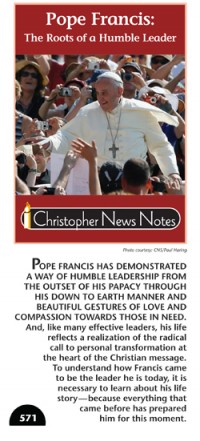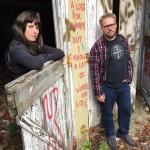 The following is the text of the Christopher News Note “Pope Francis: The Roots of a Humble Leader” (which was written by a freelancer). If you’d like a pdf or hard copy, see the end of this post:
The following is the text of the Christopher News Note “Pope Francis: The Roots of a Humble Leader” (which was written by a freelancer). If you’d like a pdf or hard copy, see the end of this post:
Pope Francis has demonstrated a way of humble leadership from the outset of his papacy through his down to earth manner and beautiful gestures of love and compassion towards those in need. And, like many effective leaders, his life reflects a realization of the radical call to personal transformation at the heart of the Christian message. To understand how Francis came to be the leader he is today, it is necessary to learn about his life story because everything that came before has prepared him for this moment.
The Language of Memories
Pope Francis was born Jorge Mario Bergoglio on December 17, 1936, into an Argentine family with roots in the Piedmont region of northern Italy. His father, Mario, and paternal grandparents emigrated to Argentina in 1929 to escape Mussolini’s fascist regime. His mother, Regina, was born in Buenos Aires.
In an interview with the Italian newspaper la Repubblica upon the election of her brother to the papacy, Pope Francis’ youngest sister, Maria Elena, recalls their grandmother Rosa Bergoglio: “Grandmother Rosa was a heroine for us, a very brave lady. I’ll never forget when she told us how, in her town in Italy, she took to the pulpit in church to condemn the dictatorship, Mussolini, fascism.”
In Buenos Aires, the Bergoglios maintained a strong network of extended family in the barrio of Flores where Jorge was born. Growing up, he loved to play games, particularly soccer, and his father would take him to play basketball at a club in San Lorenzo. On Saturday afternoons, his mother gathered the family to listen to opera, and she would provide commentary on the music and stories for the benefit of all.
In a book-length series of conversations with journalists Francesca Ambrogetti and Sergio Rubin published in 2010, then-Cardinal Bergoglio said of his childhood, “Above all, I remember my mother and father sharing with us, playing…cooking.”
When asked about cooking as a family, he explains: “My mother became paralyzed after giving birth to her fifth child, although she recovered over time. But during that period, when we got home from school, we’d find her seated, peeling potatoes, with all the other ingredients laid out. Then she’d tell us how to mix and cook them, because we didn’t have a clue. ‘Now put this in the pot and that in the pan…’ she’d explain. That’s how we learned to cook.”
Asked about the quality of his cooking, he says with characteristic good humor, “Well, no one ever died.” Bergoglio credits his “Nonna Rosa” with teaching him to pray and says he developed an affinity for family traditions due to the close relationship he had with his grandparents. He says: “My mother had my first brother when I was 13 months old; there are five of us in all. My grandparents lived around the corner, and, in order to help out my mother, my grandmother would come fetch me in the morning, take me to her house, and bring me back in the evening. My grandparents spoke Piedmontese to each other, and I picked it up from them. They loved all of my siblings, needless to say, but I had the privilege of partaking in the language of their memories.”
Poor with Dignity
Maria Elena says the family was “poor with dignity” and notes that Jorge displayed strong protective instincts towards her due to the fact that he was the oldest and she was the youngest. She adds that he reminds her very much of their father, who would gather the family before dinner to pray the rosary.
Their father was a hard-working accountant who insisted his oldest son hold a job from the time he was 13. Jorge started as a cleaner in a hosiery factory and within a few years, acquired administrative work. He continued his studies and eventually attended a technical school that specialized in food chemistry, where he found work in the laboratory.
Commenting on the experience of being employed at a young age, he says: “I’m so grateful to my father for making me work. The work I did was one of the best things I’ve done in my life. In particular, in the laboratory, I got to see the good and the bad of all human endeavor.”
Their father was also known as a joyful man, and Maria Elena says this aspect of his personality had a lasting impact on her brother: “Still today, Jorge is like Papa. He loves opera and, every so often, a good tango.”
In an interview for an article that appeared in La Stampa newspaper in 2001, Maria Elena recalls venturing to Italy with her brother when Pope John Paul II made him a cardinal. She says: “We went to Turin and then to Portacomaro, the town my father left. The place is gorgeous; we wandered about the nearby hills, then to see the house where my father was born, the garden where he played as a child, the cellars where our uncle made wine: indescribable, an emotion that you can’t communicate with words.”
Answering the Call
As a teenager, Jorge had a girlfriend named Amelia, who was part of a group of friends he went out dancing with. He had a crush on her from an early age, and she later recalled that he once hinted at his vocation when he declared, “If you don’t marry me, I’ll become a priest.”
At the age of 17, Jorge met a holy priest at his parish church. He decided to ask this priest to hear his confession, and this led to a profound spiritual encounter. He says: “I don’t know what it was, but it changed my life…. It was the surprise, the astonishment of a chance encounter…. That is the religious experience: the astonishment of meeting someone who has been waiting for you all along. From that moment on, for me, God is the One who te primerea — ‘springs it on you.’ You search for Him, but He searches for you first. You want to find Him, but He finds you first.”
He was certain of his vocation but didn’t enter the seminary for another four years. Two years later, at the age of 19, he completed his chemistry studies and told his mother he wanted to study medicine. Upon learning that he was spending all his time reading theology books, she questioned him, and he responded calmly, “It’s medicine for the soul.” Before entering the seminary, he had to undergo the surgical removal of a diseased lung and wound up convalescing in tremendous pain for weeks afterwards. He recalls hearing many platitudes that did nothing to lift his spirits, until a nun named Sister Dolores, who had prepared him for first communion, connected his suffering to the suffering of Christ.
Looking back on that time, he says: “The key is to understand the cross as the seed of resurrection. Any attempt to cope with pain will bring partial results, if it is not based in transcendence. It is a gift to understand and fully live through pain. Even more: to live life fulfilled is a gift.”
Traveling in Patience
In his interview with Ambrogetti and Rubin, Bergoglio says he joined the Society of Jesus because he was “attracted to its position on, to put it in military terms, the front lines of the Church, grounded in obedience and discipline. It was also due to its focus on missionary work.”
He came to be known among the people he served as Padre Jorge and was named Provincial Superior of the Society of Jesus in Argentina on July 31, 1973, just three months after making his perpetual profession of obedience to the pope. He served as Provincial Superior of Argentina during a period of political unrest and did much within that time to aid those persecuted by the government. In the 1980s, Padre Jorge became the rector of a seminary, which some saw as a self-imposed demotion. But it was a time in which he chose to return to teaching, writing, and hearing confessions. He even developed a reputation for being a good chef who would cook for his students.
He was appointed auxiliary bishop of Buenos Aires in 1992, became archbishop of Buenos Aires in 1998, and in 2001 John Paul II made him a cardinal. Even as cardinal, the people of Buenos Aires called him Padre Jorge, and he was known as a humble leader who lived in a simple apartment, cooked his own meals, and rode the bus as he traveled around the diocese to help the poor and visit the sick.
He recalled for Ambrogetti and Rubin a time when he was auxiliary bishop and a troubled man approached him and asked to make a confession. He instructed the man to wait for another priest because he had a train to catch for an important retreat he was giving. He hurried off but quickly realized he was wrong for doing so and had been developing an attitude of superiority. Immediately correcting his behavior, he went back to hear the man’s confession. When he arrived late for his train, he found that it had been delayed and was waiting for him.
Padre Jorge says it was in this moment that he learned to “travel in patience.” He says: “To travel in patience means accepting that life is a continuous learning experience. When you’re young, you believe you can change the world, and that is good, that’s the way it should be. But later, when you seek this change, you discover the logic of patience in your life and the lives of others. To travel with patience is to make peace with time, and allow for others to open up your life for you.”
Regarding the future of both her brother and the Church, Maria Elena says, “The main concern I have for my brother is not to leave him alone. Francis is asking the Church to resume her journey, but we, the faithful, must walk with him.”
“What is the light like that Jesus offers us? The light of Jesus can be known because it is a humble light, it is not a light that imposes itself: it is humble. It’s a meek light, with the strength of meekness. It’s a light that speaks to the heart, and also a light that offers you the Cross. If we, in our inner light are meek, if we hear the voice of Jesus in the heart and look on the Cross without fear: that is the light of Jesus.”
– Pope Francis
To receive a pdf or mailed copy of “Pope Francis:The Roots of a Humble Leader,” email your request to [email protected]












